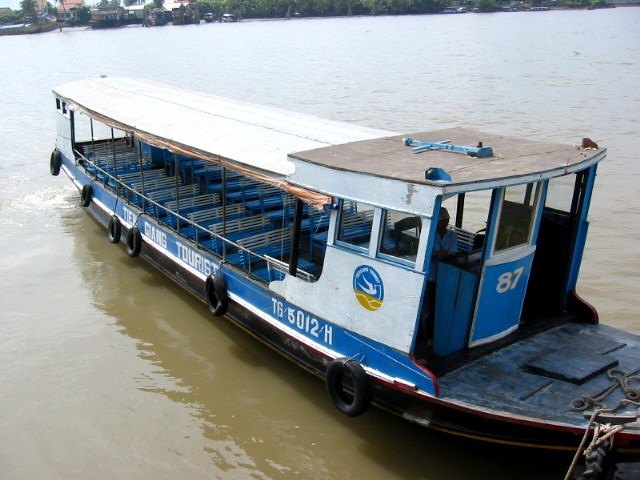
A Trip Down the Mekong River
The one day trip that we did take while staying in Ho Chi Minh City was down the famous Mekong River. We were picked up by a bus at the hotel and driven to the small town of My Tho, were we boarded a launch to cruise the river. We were joined on our trip by a gentleman from Norway, and a Vietnamese American who was returning for a visit. The photo to the left shows the larger launch that we took to and from My Tho, while the photo to the right shows the two other people on the tour and the launch operator flashing the ubiquitous "peace" sign.

 The Mekong River is a major
thoroughfare in this region where roads are difficult to build
and always congested and slow. If it is used by people in the
cities, chances are you can find it being transported on the
Mekong's muddy waterway. In many respects the Mekong river
reminded me of the Mississippi River around New Orleans,
always bustling with commerce and tourism. After about 30
minutes on the launch, we disembarked at Dragon Island. From
there we would tour villages on these islands on foot and by
sampan. The photo to the left shows a load of sugar can being
transported on the Mekong River, while the photo to the right
shows the woman ready with the bowline as we ease into the
landing at Dragon Island.
The Mekong River is a major
thoroughfare in this region where roads are difficult to build
and always congested and slow. If it is used by people in the
cities, chances are you can find it being transported on the
Mekong's muddy waterway. In many respects the Mekong river
reminded me of the Mississippi River around New Orleans,
always bustling with commerce and tourism. After about 30
minutes on the launch, we disembarked at Dragon Island. From
there we would tour villages on these islands on foot and by
sampan. The photo to the left shows a load of sugar can being
transported on the Mekong River, while the photo to the right
shows the woman ready with the bowline as we ease into the
landing at Dragon Island.

 Winding our way up a
narrow and muddy path, we came to our first stop, a small
village about 200 meters inland from the river. The main
livelihood of this village was creating treats, mainly of the
sweet or spicy variety, from rice. The first step in this
process is shown in the photo to the left, essentially popping
the rice in a wok. To ensure uniform heat, the rice is mixed
with the sand, then the sand is sifted out, leaving the hot
rice. It is then bonded into sticks, using combinations of
molasses, honey, and spices. Some bars are just sweetened rice
(like Rice Krispy bars), while some are spicy, and others are
mixed with nuts. They were tasty treats, which we enjoyed the
remainder of our trip. The photo to the right shows a women
weighing and bagging one of the finished products, in this
case a coconut treat.
Winding our way up a
narrow and muddy path, we came to our first stop, a small
village about 200 meters inland from the river. The main
livelihood of this village was creating treats, mainly of the
sweet or spicy variety, from rice. The first step in this
process is shown in the photo to the left, essentially popping
the rice in a wok. To ensure uniform heat, the rice is mixed
with the sand, then the sand is sifted out, leaving the hot
rice. It is then bonded into sticks, using combinations of
molasses, honey, and spices. Some bars are just sweetened rice
(like Rice Krispy bars), while some are spicy, and others are
mixed with nuts. They were tasty treats, which we enjoyed the
remainder of our trip. The photo to the right shows a women
weighing and bagging one of the finished products, in this
case a coconut treat.
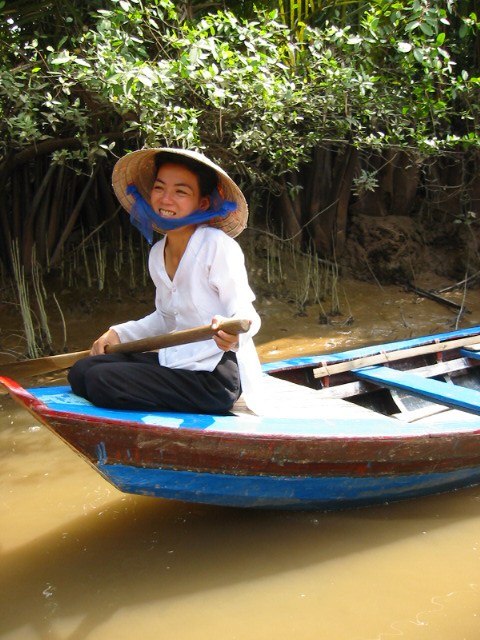
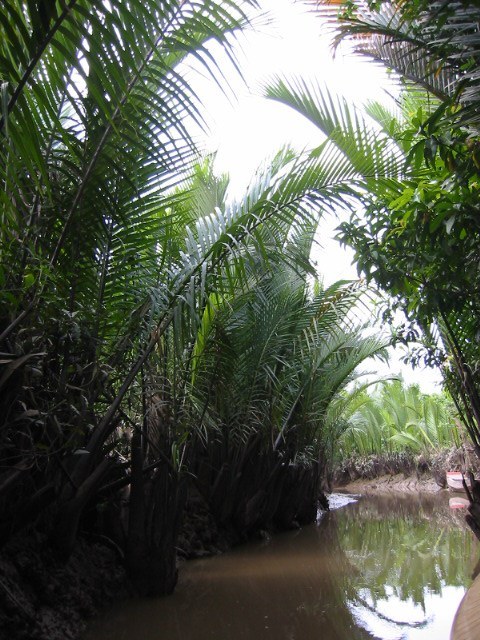 After enjoying a rice treat, we
boarded sampans to go a bit deeper into the interior of this
complex of islands in the Mekong River. The only way to travel
is by sampan, a small boat with gunwales like a canoe, but
beamier, like a small rowboat. They have a paddler in the
front, one in the back, and can take about 3-6 people,
depending upon their size. The sampans do share another
characteristic with canoes--they are very tippy, and the first
few minutes are a bit uneasy, until one becomes accustomed to
the motion and learns never to react suddenly. We were paddled
to Unicorn island via a narrow waterway filled with
overhanging vegetation. The photo to the right shows one of
the paddlers, while a view of the channel we were negotiating
is shown in the photo to the right.
After enjoying a rice treat, we
boarded sampans to go a bit deeper into the interior of this
complex of islands in the Mekong River. The only way to travel
is by sampan, a small boat with gunwales like a canoe, but
beamier, like a small rowboat. They have a paddler in the
front, one in the back, and can take about 3-6 people,
depending upon their size. The sampans do share another
characteristic with canoes--they are very tippy, and the first
few minutes are a bit uneasy, until one becomes accustomed to
the motion and learns never to react suddenly. We were paddled
to Unicorn island via a narrow waterway filled with
overhanging vegetation. The photo to the right shows one of
the paddlers, while a view of the channel we were negotiating
is shown in the photo to the right.
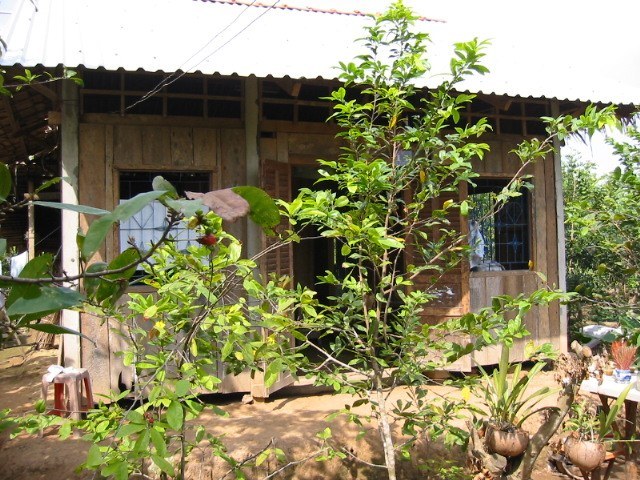
 On
Unicorn Island we encountered larger and more diverse
settlements. Walking up a small path, we soon found ourselves
at a small family compound surrounded by fruit trees. The
photo to the left shows one of the houses in the compound,
room for a family, while the photo to the right shows the
small shrine outside the house, replete with offerings for the
gods. At the center of the compound was a pavilion, where
visitors were served the fresh fruit grown by the family. We
got the impression that it is more profitable running the
family business as a tourist site than it is to simply
rely on the sale of fruit. After being served a variety of
tasty fruits, other family members then entertained us with
traditional village songs, using homemade instruments. The
photo to the left shows us being served fresh fruit in the
pavilion, while the photo to the right shows
On
Unicorn Island we encountered larger and more diverse
settlements. Walking up a small path, we soon found ourselves
at a small family compound surrounded by fruit trees. The
photo to the left shows one of the houses in the compound,
room for a family, while the photo to the right shows the
small shrine outside the house, replete with offerings for the
gods. At the center of the compound was a pavilion, where
visitors were served the fresh fruit grown by the family. We
got the impression that it is more profitable running the
family business as a tourist site than it is to simply
rely on the sale of fruit. After being served a variety of
tasty fruits, other family members then entertained us with
traditional village songs, using homemade instruments. The
photo to the left shows us being served fresh fruit in the
pavilion, while the photo to the right shows  the family performing traditional Vietnamese
the family performing traditional Vietnamese 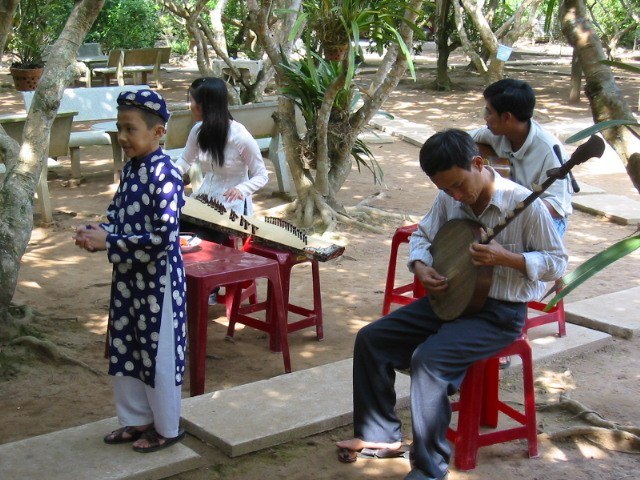 songs.
songs.
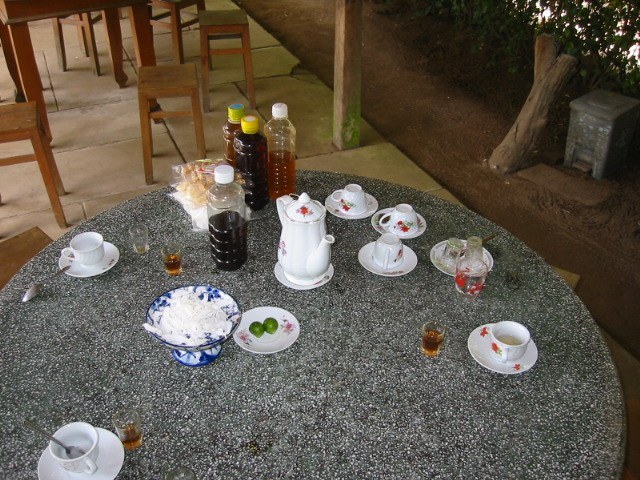
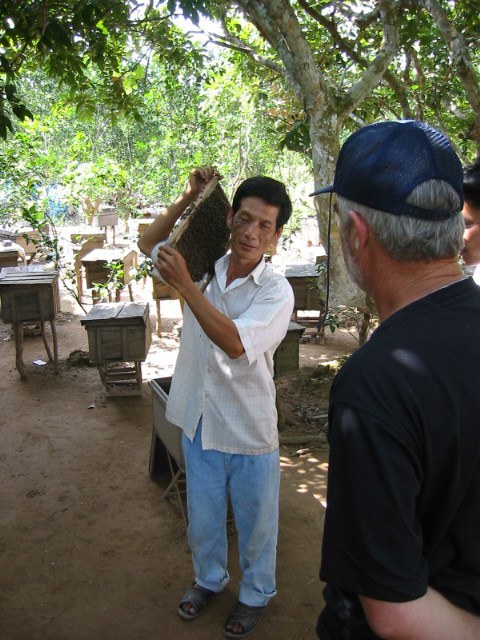 Following
our visit to Unicorn Island we returned to Dragon Island to
sample a bit more of local culture. The next village that we
visited specialized in the making of honey. We were treated to
a sip of the local liqueur, plus tea with honey; the remnants
of our tea party is shown in the photo to the right. In the
tropics honey consumption carries with it inherent risks, as
we were constantly bombarded by bees as we sat at the table.
The guides and villagers always insisted the bees were of
whichever sex does not sting, but I doubt their eyes were keen
enough to make such anatomical distinctions at a glance! After
sampling the tea, we visited the hives. The photo to the left
shows a confident beekeeper hoisting an entire hive of bees in
casual conversation, while we maintain a respectful distance.
Following
our visit to Unicorn Island we returned to Dragon Island to
sample a bit more of local culture. The next village that we
visited specialized in the making of honey. We were treated to
a sip of the local liqueur, plus tea with honey; the remnants
of our tea party is shown in the photo to the right. In the
tropics honey consumption carries with it inherent risks, as
we were constantly bombarded by bees as we sat at the table.
The guides and villagers always insisted the bees were of
whichever sex does not sting, but I doubt their eyes were keen
enough to make such anatomical distinctions at a glance! After
sampling the tea, we visited the hives. The photo to the left
shows a confident beekeeper hoisting an entire hive of bees in
casual conversation, while we maintain a respectful distance.
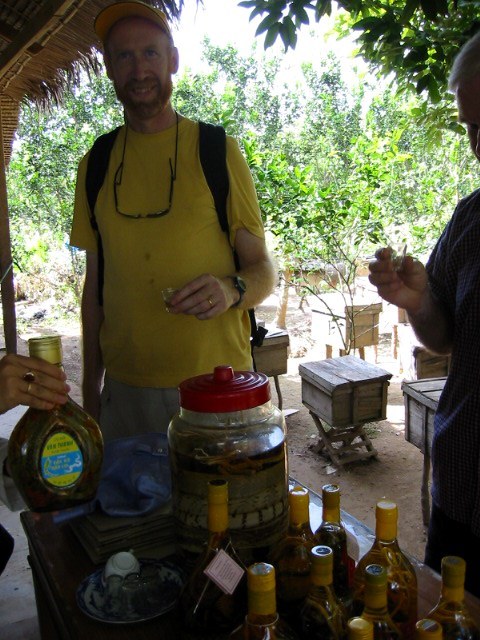
 Honey was not the only treat that we
encountered in the village. As we made our way to the main
pavilion, a man beckoned us toward a large glass container.
Inside the container were three cobras, neatly coiled on top
of one another. The liquid inside the jar was saki, aged three
years in the cobra carcasses. What do you do with this? Yes,
that's right--you drink it. Urged on by the dreaded "triple
dog dare," and heartened with the promise that you will "look
and feel five years younger," I quickly downed a shot of the
miracle substance, to Tracy's horror. And the taste? Exactly
the same as when you siphoned gas from a car as a kid and got
a mouthful (what, you didn't do that?). But it got worse: the
only foodstuff available to cut the taste turned out to be
very spicy. I left the pavilion with a mouth on fire. The
photo at the upper right shows the dreaded cobra cocktail. By
clicking on the picture you can see a close-up of the jar. The
photo to the right shows a typical Vietnamese house,
which holds the extended family. Three generations live under
one roof, and when sons marry, they just tack on another
addition. The house
pictured above had a large kitchen at the near end (the large
opening in the photo), while the remainder of the area was devoted to sleeping quarters. Two
other crafts that were in evidence in the village were
Honey was not the only treat that we
encountered in the village. As we made our way to the main
pavilion, a man beckoned us toward a large glass container.
Inside the container were three cobras, neatly coiled on top
of one another. The liquid inside the jar was saki, aged three
years in the cobra carcasses. What do you do with this? Yes,
that's right--you drink it. Urged on by the dreaded "triple
dog dare," and heartened with the promise that you will "look
and feel five years younger," I quickly downed a shot of the
miracle substance, to Tracy's horror. And the taste? Exactly
the same as when you siphoned gas from a car as a kid and got
a mouthful (what, you didn't do that?). But it got worse: the
only foodstuff available to cut the taste turned out to be
very spicy. I left the pavilion with a mouth on fire. The
photo at the upper right shows the dreaded cobra cocktail. By
clicking on the picture you can see a close-up of the jar. The
photo to the right shows a typical Vietnamese house,
which holds the extended family. Three generations live under
one roof, and when sons marry, they just tack on another
addition. The house
pictured above had a large kitchen at the near end (the large
opening in the photo), while the remainder of the area was devoted to sleeping quarters. Two
other crafts that were in evidence in the village were 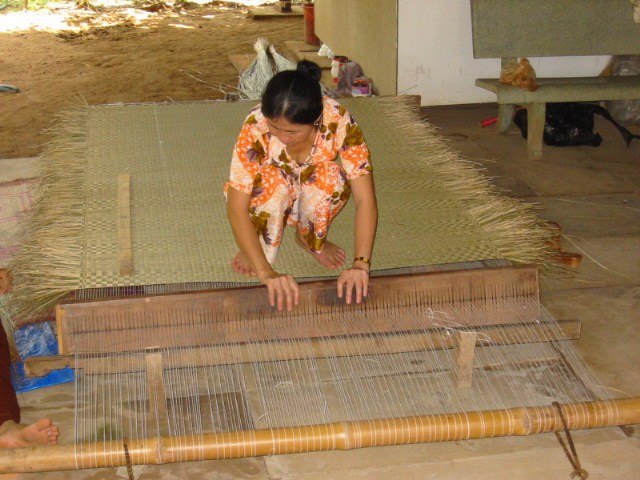 weaving, shown in the photo at the middle left,
and candy-making. Everything is done by hand, and out of
doors. These small out of the way villages are rather
remarkable for the volume of crafts they produce (including
footwear, wooden carvings, and textiles) as well as remaining
remarkably self-sufficient when it comes to their own basic
needs.
weaving, shown in the photo at the middle left,
and candy-making. Everything is done by hand, and out of
doors. These small out of the way villages are rather
remarkable for the volume of crafts they produce (including
footwear, wooden carvings, and textiles) as well as remaining
remarkably self-sufficient when it comes to their own basic
needs.
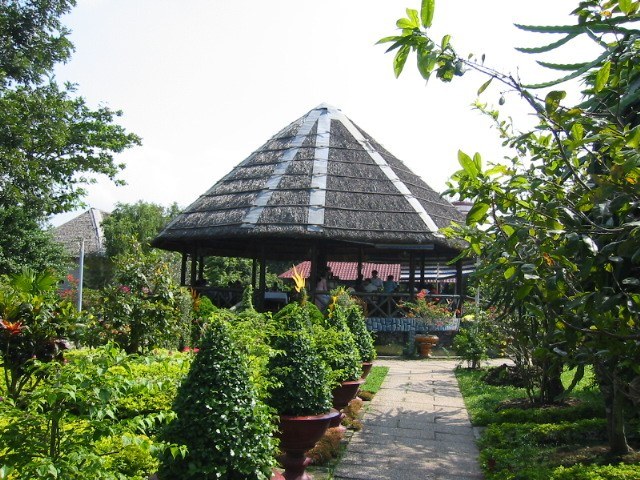
 Following our tour of these arts, we
returned to the main center for a delicious fish lunch (we
eschewed some of the local delicacies, although our guide
assured us that the rat and the snake was delicious).
Following our leisurely lunch (which also included a chicken
and prawns, we boarded the launch for the trip back to the
bus, and from the bus to our hotel. The photo at the lower
left offers a view of the dining pavilion on Dragon Island.
Below is a video tour of this trip, made some years later by
Alison Linh. It provides a nice overview of the experience.
Following our tour of these arts, we
returned to the main center for a delicious fish lunch (we
eschewed some of the local delicacies, although our guide
assured us that the rat and the snake was delicious).
Following our leisurely lunch (which also included a chicken
and prawns, we boarded the launch for the trip back to the
bus, and from the bus to our hotel. The photo at the lower
left offers a view of the dining pavilion on Dragon Island.
Below is a video tour of this trip, made some years later by
Alison Linh. It provides a nice overview of the experience.
Video of Mekong River Cruise by Alison Linh